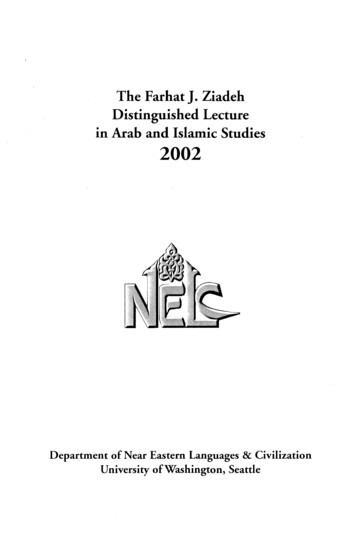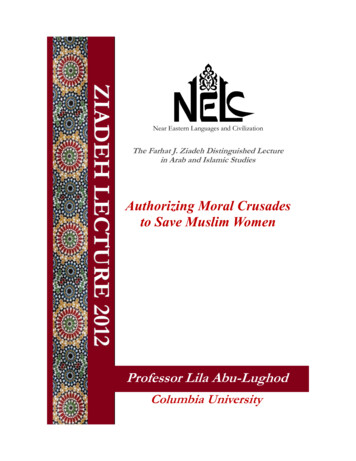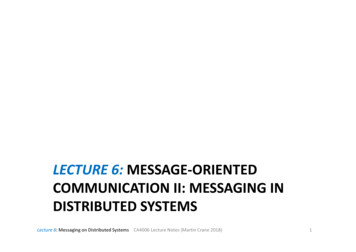
Transcription
The Farhat J. ZiadehDistinguished Lecturein Arab and Islamic Studies2002Department of Near Eastern Languages & CivilizationUniversity ofWashington, Seattle
Dear fi·icnds and colleagues;\XIe are very pleased to provide you with a copy of the Inaugural Farhat J. ZiadehDistinguished Lecrure in Arab and Islamic Studies: "Gibran Kahlil Cibran Between Two lilknnia," deliveredDr. Irfm Shahid on April 30, 2002.The Farhat J. Ziadeh Distinguished Lectureship is dedicated to the promotion andcelebration of excellence in the field of Arab and Islamic studies and was formally mdowed2001. Farhat Ziadd1 was born in Ramallah, Palestine, in I') 17. He received his B.A.from the Americmof Beirut in 19.37 and his LL.B from the University ofLondon in 1940. He was admitted to Lincoln's Inn, London, and became a Barrister-atLaw in 1946. In the last years of the British Mandate, he served as a Magistrate for theGovernment of Palestine befc re eventually moving with his Eunily to the United States.He was :lppoinred Professor of Arabic and Islamic Studies at Princeton where he taughtuntil 1066, at which time he moved to the University of Washington. The ZiadehLectureship is a tltting triburc to his countless contributions to the building of Near EasternStudies at rhe University of Washington, and extraordinary contributions to and influenceon the field of Arabic language and literature and the study of Islamic law in the U.S. andthrough his long list of publications, but also through the countless studentswhom he has mt·ntored and colleagues with whom he has collaborated.The Zi,ldeh Endowment fimd has been a labor of love, involving generous contributionsover several years from :l very, very long list of people. These include many students andand above all Farhat and his wife Suad themselves, and their familymembers. If you have been one of these contributors, we want to extend once again ourwarmest thanks f()r your continuing participation in helping make this lectureship serieslll lY also find an elt:crronic copy of Dr. Sluh!d's lecture on our departmental web sire:http://depts.washington.edu/nelc/, as well as other inf(mnation about the Department:mdprogramsonlineand contact inlimnation.,\lichael A. Williams(:hair, Near EasternI ,anguagesc:ivilizarion
Department of Near Eastern Languages and CivilizationUniversity of Washington, SeattleThe Inaugural Farhat J. Ziadeh Distinguished Lecturein Arab and Islamic StudiesApril30, 2002GIBRAN KAHLIL GIBRANBETWEEN TWO MILLENNIAProfessor Irfan ShahidSulttmate of Oman Professor ofArabic and Islamic Literature atGeorgetown University
Irfan ShahidDr. Irfan Shahld is the Sultanate of Oman Professor of Arabic and Islamic Literature atGeorgetown University, Washington, DC. His undergraduate work was done at Oxford,where he received his Bachelor's degree in Classics and Graeco-Roman history; his graduatework was done at Princeton University, where he did Arabic and Islamic studies and wherehe received his Ph.D. for work on the theme ''Early Islam and Poetry." Prior to hisappointment at Georgetown, he held positions at UCLA and Indiana University,Bloomington.Dr. Shahid's very extensive publications range over three major research areas: Qur'anicStudies, Arabic Literature, and the fascinating history of relationships between Arabs andthe late Roman and Byzantine empires, on which topic he is the author of several majorand well-known volumes, all published by Dumbarton Oask: Rome and the Arabs (1984);Byzantium tmd the Arabs in the Fourth Century (1984); Byzantium and the Semitic Orientbefore the Rise oflskzm ( 1988); Byzantium and the Arabs in the Fifth Century (1989); Byzantiumand the Arabs in the Sixth Century ( 1995- ) . He has also written in Arabic a 600-page bookon Ahmad Shawqi, the foremost Neo-Classical Arab poet of modern rimes and on ArabAmerican Literature, of which Gibran was the most outstanding representative.2
GIBRAN KAHLIL GIBRAN BETWEENTWO MILLENNIA*Irfan ShahidIn the course of the year, 2000, the so-called Millennium Year, many lectures were deliveredby representatives of various nationalities in which they reviewed the achievements of theirrespective peoples in the course of the twentieth century, together with their hopes andtheir expectations for the rwenry-first. The Arabs, or their twenry-two states- to myknowledge- have not saluted the end of the century or the dawn of the new one throughsuch celebratory lectures, and we all know why: it has not been a good century in Arabhistory.Lectures of a different kind were also delivered and exhibitions were mounted, celebratingWestern artists and men of letters. Such was the case in England, which in its NationalGallery, rhe Tate Britain, has mounted an exhibition that lasted tor some three months,from November 2000 till February 2001, thus straddling both centuries. It displayed inits entirery the work of one of her artistic geniuses, and conveniently for our purposetonight, it was none other than William Blake, Gibran's "ancestor in the spirit." The threemonths of the Exhibition witnessed a torrent of lectures, seminars, books, articles,conferences, courses, performances, films, videos and workshops, all in Blake's memoryand honor. The critics rehabilitated him as a genius under whose influence many modernartists are now working, and also poets reHected in such titles as "The Blake Renaissance inModern Poetry." 1It was in Paris that Auguste Rodin is said to have called Gibran "The William Blake ofthe 1wentieth Century," when he discovered that Gibran was under the jurisdiction of twoMuses: painting and literature. Indeed, Gibran was such and the study of Gibran's literaryand artistic oeuvre is most profitable when his natural affiniry with Blake and the latter'sinfluence on him are recognized and investigated. The judgment of the distinguishedFrench sculptor must have confirmed Gibran's faith in his artistic and literary talents andin the intimate relationship that obtained between the two, especially in those works of histhat united both, as in literary works that he himself illustrated, such as his masterpiece,The Prophet.These, then, are two of the three inspirations of this lecture: the William Blake Exhibitionat Tate Britain in London, and the dawn of the New Millennium, to both of which I wasfully exposed for an entire year, my Sabbatical spent in my alma mater, Oxford. Theyinspired me to write a paper on what can be done for Gibran in the context of these twoinspirations, similar to what has been done for Blake. Shortly after I returned to my basein Washington, the tragic events of September 11 took place, which changed the image ofthe Arabs and Islam in America trom what it had been before in the twentieth century, towhat it has become in the twenry-tlrst. They immediately provided a third inspiration torewriting this lecture on Gibran, whom these events have raised to a new level of relevance-,that of the image. And i! propos of September, the eleventh, a quotation from Gibran isvery apposite. In an open letter, which he addressed to Americans of Arab origin on the3
various constituentsfi:Jllows:citizenship, one sentence is especially relevant, and it reads as"lr is to stand before the'Iowers ofNew York and Washington, Chicago and San Franciscosaying in your hearts 'I am the descendant of a people who built Damascus and Byblos,Tyre, Sidon, and Antioch, and [am here to build with you, and with a will."' The quotationspeaks for itself'So much for an introduction. In a lecture that is tri-partite in inspiration and hence instructure,' which presents Gibranas a figure in world literature, it is necessaryeven incumbent, to re-examine the truth about his place within the caravan of internationallyacclaimed men ofletters, especially as he has always been in the center of controversy, onewho has never suffered from any lack of admirers or detractors, both in his lifetime andposthumously. In the course of only the last quinquennium, two substantial books haveappeared on him, one laudatory,' the other derogatory. 0 It is, therefore, to addressing thisquestion that the first part of this lecture is devoted.-1Gibran has been the gift of Lebanon and the Arab peoples to America and the ArabAmerican community. No Arab author has reached so many million Americans in thecourse of almost a century as Gibran has, and no Arab-American literary figure has attainedthe globtl! reputation that Gibran has, after being translated into some twenty of the languagesof the world. Although his Prophet has sold, according to one estimate/ ten million copies,thus outselling all American poets from Whitman to Eliot, the American literaryestablishment has not given him the recognition he deserves, and has not admitted him tothe American literary canon. The Ivy League Universities, such as Harvard, Yale, andPrinceton, do not teach him in their departments of English or Comparative Literature,and it is only recently that he came to be taught, but in a non-Ivy League University, thatof Maryland, by Professor Suhayl Bushrui. The most American of all philosophies,pragmatism, has not been applied to Gibran, the philosophy that judges the validity of awork by its results. As has been said, ten million people in all walks of life and in variouscountries and periods have bought The Prophet and read it, a reflection of the fact that thepragmatic test has been unofficially applied to it, and their favorable judgment stronglysuggests that The Prophet has passed the pragmatic test. Indeed, ten million cannot beentirely wrong. Yet, The Prophet has not passed the threshold of the Canon.In anthologies of English or American literature, Gibran does not appear, not even inthose that are known for diversity in their cultural inclusions, such as the prestigious TheHeath Anthology o/American Literature, 8 where there is not a line from Gibran. Theconfusion that attends Gibran and his work extends, even pervades, the libraries andbookshops, where The Prophet is not to be found on the shelves reserved to literature, butto religion, a fact to which the title of the book, The Prophet, contributed its generousshare, thus making Gibran a religious figure, and worse still, an Oriental guru. In thisrespect, Gibran stands in sharp contrast with another countryman of his, namely George
immediately acceptedFrenchEstablishment andindeed has heeome one of the major representatives of Surrealism in French Literature.then, is the trurh about Gibran as an artist and a man ofletters? I shall begin withGihran as a man of letters.As a man of letters in Arabic, Gibran has stood the test of time, the best of all critics. Itbas been a century since his literary career began, when his first publications received awide and immediate vogue, and they have remained such till the present day, thus illustratingEzra Pound's dictum on true literature, that it is "news that stays news." In Arabic, hisplace is secure and has been recognized by fair and objective critics. As is well known, hepioneered almost all the literary genres which he and his colleagues introduced into Arabic,such as the essay, the short story, the novel, and the drama, rhus relieving Arabic literatureof its medieval look and endowing it with all the aspects of contemporary Western literature.In poetry, he wrote in the traditionctl idiom of classical Arabic prosody and in that of freeverse, and he is rightly considered the father of modernity in Arabic literature, b()[h inprose and poetry.''Although his creativity as a man of letters took place in America, he and his group ofArab-American writers revolutionized the course of Arabic literature in the Arab homelandas representatives of the new school of Romanticism in Arab literature, antedating andpreluding the rise and development of the romantic movement in the Arab world, throughtheschool and then the Apollo school, both in Egypt. Thus, from their base inAmerica, the Arab-American writers presided over by Gibran, proved to be the catalyst inthe literary renaissance of the Arab world in its vast Afro-Asian extent.In addition to his being one of the classics of modern Arabic literature, he had the goodfortune of having one of his best poems set to music and sung by the foremost singer in theArab world, the Lebanese chanteuse, Fayn!z, who has charmed audiences in the Arab world,from Gulf to Ocean and also western audiences even in America and in Europe. In sodoing, Fayruz has enabled Gibran's literary legacy to be spread among millions of people towhom his writings had remained terra incognita; bur now, through the auditory dimension,a lyric of his bas been wed to music and song, arts on which he had written one of hisearliest works,So much f(n Gibran's oeuvre in Arabic and its secure place in the Arab world. ButGibran was a bilingual literary artist, and in the last decade or so of his lite, he turned toEnglish, through which he wrote his works notably his masterpiece The Prophet, the workon ·which his reputation in the western non-Arab world rests, a single book he wrote in thetwenties of the last century, a slim volume that can be read in an hour. But the non-Arabworld at large, with the exception of a few specialists among the Arabists, know practicallylittle or nothing about him and his work other than his authorship of Ihe Prophet. Hisastounding versatility and the many facets of his persomt, let alone his tlnima, remainunknown to the majority of his admirers with the result that his image is opaque and itsoutlines are blurred. As has been already said earlier in this paper, Gibran, respected andloved by millions in all walks of life, has yet to be accepted by the American literaryestablishment. In a paper delivered at the Library of Congress in Washington in 1995,which later appeared in print, I have explained in detail the reasons why Gibran has not yet5
mtoHall of Fame, the American LiterarywSome distinguishedcritics and theorists would like to dismantle this Canon. They do not think muchof it and consider ir a construct. In the words of one of them, Terry Eagleton, "it is aconstruct, fashioned by particular people for particular reasons at a certain time. " 11 However,the Canon remains important, even in Classical Arabic literary theory, ref1ected in thebetween the eighth century critic Khalaf al-Ahmar, and one who told him "If Ithink a poem is good, [ do not care a hoot t(Jr what you or your coterie, the critics, sayabout it." To which Khalaf replied "You may consider ayou have a good coin, burof what avail is it, if the money changer in the market tells you it is not a good penny?" 12For Gibran to appeal to the sophisticated literary critic, the latter has to be made awareof Gibran's oeuvre in its entirety, the oeuvre that made him the acknowledged dean ofArabic letters in the first quarter of the twentieth century, the one who revolutionized thecourse of that literary tradition. Bur that oeuvre is a closed book to rhe critic who is innocentof Arabic. Here comes the importance of rendering Arabic Gibran into an English versionthat can reflect the art of Gibran in the original Arabic. Two of the Classics of WorldLiterature are trtmsltltions from the world of the Near East, the English Authorized Versionof the Bible and the Fitzgerald English version of the Rubaiyyat of Omar Khayyam. uThe task will not be easy in the translation of certain portions of Gibran's work. Arabicand English belong to two entirely different families oflanguages and it has been truly saidthat "in Arabic, as in all other literatures, the canons of wit, elegance, and artistry in writingwere dictated by the genius of the language." 14 Shakespeare, for instance, translates wellinto a cognate language like German, bur much less well into French, a Romance language.And Arabic is much further removed from English than French. Hence, some ofGibran'stranslations into English may sound florid and artificial, but they do not so sound in theoriginal Arabic. It would, therefore, be unrealistic ro expect translations ofGibran's worksfrom Arabic to rival rhe Authorized Version and the Rubaiyyat, but hopefully they mightbe with measurable distance from them. Then, and only then, will The Prophet cease toexist in splendid isolation, but will be related to the rest of Gibran's oeuvre in its entirety,which established him as the foremost man ofletters of his day, and this relation will drawattention to the f.'lct that The Prophet proceeded from the same creative faculty that hadproduced the critically acclaimed previous ones, and that Gibran was one of the genuineliterary voices of the twentieth century. Even this may not be enough to have Gibran enterthe Canon. The case of William Blake, with whose name he was linked, is illuminating.That artist-poet was almost rejected by contemporaries, some of whom even declared hima lunatic. Blake had to wait for a hundred years before he was admitted to the Canon, andonly when a major poet of the twentieth century and member of the Canon, namelyWilliam Butler Yeats, accepted him and saluted him in one of his poems. The case ofNaguib Mahfouz is also i! to invoke. Few outside the Arab World had heard ofhim, and it was only when he was awarded the Nobel Prize a few years ago, that he was1accepted world-wide. Recently, in one of the issues of the' EdwardSaid endorsed the judgment of the Nobel Prize Committee on Mahfouz and wrote a longarticle in favor of him.So much fiJr Gibran, the literary artist, the man of Letters, and for the Anglophoneworld. I turn now to Cibran, the visual and graphic artist.6
-IICibran'sin the history of art is nor established or so clear as his place in literature.And yet it was as an artist that he began his career in Boston, then in New York, and it wasas a student of art that he came to Paris in 1908,- the only period in his life when hesrudied his craft in a truly artistic environmenr, amid the giants of the first decade of thiscentury, an opportunity that was never given him as a literary artist. By the time of hisdeath, he had left behind him some 400 pieces he had drawn and painted, pieces whichnowadays are distributed in various parts of the world. His art has received much lessattention than his literary work, and thus it, roo, has sufiered what his Prophet has from theWestern critics, but for a different reason.Four years ago, the Institut clu Moncle Arabe (IMA) in Paris mounted an exhibition ofhis paintings and it was very i! propos, since it was in that city that Gibran received thenearest approximation to what might be termed a formal and serious education in art.The exhibition was very imaginative as it presented the work of Gibran chronologicallyand in conjunction with other artists contemporary with Gibran, who influenced him, ajuxtaposition that enabled critics to compare and contrast. A catalogue prepared by 'IsaMakhluf and Ibrahim al-Aiawi presented the exhibits with critical comments. 16England, as has been said, mounted an exhibition in the National Gallery of Art, TateBritain, for the work of William Blake, which displayed him in his entirety, some 500pieces; the exhibition lasted for three months straddling the two years of the two centuries.What England and critics have done for the memory of their Blake has tempted me todevote the second part of this paper to what can be done for Gibran the artist, in the lightof Blake's exhibition.This is tpposite f()f three reasons: Blake exercised the greatest influence on Gibran,whether or not Auguste Rodin said so; because Blake was omitted from the Paris exhibitionof Gibran's work in 1998 rightly and understandably, as the exhibition, mounted in Paris,presented Gibran in the French cultural milieu under French, not English artistic influence;the Blake exhibition at the Tate elicited so many positive and favorable comments onBlake's art, which had previously been under fire in certain circles. In this respect, Gibranis in the same boat as Blake and, so, a treatment of Gibran's art in the Blake context willhopefully contribute to a better understanding and appreciation of Gibran's art, especiallysince Gibran still has some hostile critics.-ABefore I treat Gibran and Blake, I should like to say a few words on Gibran's art, not asa professional art historian, which I am not, but as an historian and a cultural analyst:Gihran was precocious and self-taught. He was 25 years old when he came to Parisf(Jr two years, the only time he could be said to have had some formal training inart.7
Unlike otherhis life was relatively short. He died at the age of 48. Goetheanddied in their eighties and Blake, the closest one to him, lived 21 yearsmore than Gibran did, and it was during these last twenty years of his life that Blakereached the height of his powers. One could imagine what Gibran would haveachieved if he had lived twenty more years.}-During this short life, he was plagued by ill-health, three deaths in his family, all ofconsumption, was an uprooted immigrant who had to live his childhood inChinatown, underprivileged, socially and otherwise. Furthermore, while othergraphic artists were only such, he was both an artist and man of letters.4-Yet in spite of all this, he left behind him some 400which reHected hisversatility. He was surrounded by jealous critics. While in Paris, he apparentlyrejected the new innovative styles and schools which Paris witnessed early in theccnrury, including Cubism, and preferred to stay in the fold of Classical art and thatof the lralian Renaissance. Critics took exception to this, but his negative reactionadmits of another explanation, namely his independenr nature and r!rm artisticwill. The f;1ct, however, remains that the Societe National des Becmx Arts did acceptone of his paintings, "Autumn," for its Spring Salon and requested more for itsAutumn Salon, not one or two but six more, which suggests that his talent was bythen recognized in Paris itself.-BAfter visiting the gallery, '[ue Britain, and reading the multitude of articles that haveappeared on Blake as a result of the Exhibition, here are some observations on Gibran andhis art in this context, which, by comparison and contrast could be helpful for a betterunderstanding and appreciation of Gibran and of his work. 1H1-Blake was hardly recognized in his lifetime, although towards the end of his life, theEnglish Romantics, such as Wordsworth and Coleridge, gave him some recognition.A member of the Establishment, the poet-laureate, Robert Southey, declared one ofhis works "perfectly mad." He had to wait some hundred years befc re a major poet,Yeats, rehabilitated him. Gibran was more fortunate, his genius was recognizedimmediately and throughout his life, as well as posthumously, ever since his deathin l 931. This could lead to complacem:y, but it should not; on the contrary, itshould lead to the further exploration of new dimensions of his genius as Britainhas done lately for Blake. The beginning of a new Millennium is a most opportuneoccasion to do that and [ shall touch on this in this paper.2-Critics nowadays believe that many artists in England, even some two centuriesafter the death of Blake, are actually working under his influence. Is it possible thatsome Lebanese artists have worked under the inHuence of Gibran as they did inliterature. Some have argued for Gibranic inHuence while others have denied it.Whatever the truth may be, Gibran might he considered as a participant in thehistory of Lebanese art in much the same way that he is considered in LebaneseLit.erature. 1"8
wereBlake,all English Romanticmm of letters, was asupporter of rhe ideals of the French Revolution. These were Republicans, evenBonapartists at least initially, ranged against the Monarchical system. So was (;ibrana rebel against the social and ecclesiastical feudalism that was rampant in the Lebanonof his time. He wrote trenchandy against it and also against the hold of the OttomanSultans over not only Lebanon, but also the Arabs. The rebelliousness of both didnor remain academic and both were political activists.4-Roth had in them deep religious strands. In the case of Blake, it was reHected inmany of his pronouncements, in his early career as an engraver in WestminsterAbbey, and in his illustration of some of the books of the Bible. So was Gibran,whose background is also reflected in his writings and in the last works he publishedin English, in which Jesus of Nazareth cuts such a large figure. Rut both wereunorthodox in their understanding of Christianity and disliked organized religion.5-The rebel in both of them against the social, religious and political order foundexpression in their art, graphic and literary. In his paintings, Blake, althoughaudacious and original, is often, even more often than not, incomprehensible andsometimes repulsive, at least to my taste. 20 Gibran remained in the fold of Classicalart and in that of the Italian Renaissance and so he rernained comprehensible evenin his mystical paintings, which do pass the sobriety test. Cibran's rebellious spiritfound expression in his literary work, through which he truly revolutionized modernArabic literature.6-Both were cosmologists in their consciousness. Gibran conceived himself as anatom riding an earth that was a planet revolving around the sun, and so parr of acosmos. For his cosmology, Blake went to the length of constructing a mythology,involving also a cosmogony, the birth of the universe. And it all sounds and seemsbizarre especially when provided with paintings. Gibran's feet remained on theground, and his mythology, unlike that of the occultist that was Blake, belonged toancient Greece lnd the Semitic Orient, involving such figures as Orpheus, Asrrate,md Tammuz, not unfamiliar to the Western reader. His interest in Tammuz, theSemitic God of regeneration, may have had some influence on the rise of the literaryTammuz Movement in Lebanon, which came after him. He believed in a Universalspirit and he expressed his cosmology powerfully and beautifully in the best essayMawlidi. Blake'she wrote on the occasion of his rwenty-t!ft:h birthday,eccentricities suggest that he may have sutTered from hallucinations, but Gibrandid not, and the Greek concept of "Divine Madness" could be invoked in his case.7-Gibran never married, but love played the most important role in his life by his ownadmission. At least five different types of love are associated with Gibran:(l) familial love towards his mother, his sister and brother, all of whom died ofconsumption; (2) intellectual and spiritual love toward Mary Haskell, his guardianangel and benefactress; (.1) carnal or recreational love towards the many women bywhom he was always surrounded and adored; (4) epistolary love through a celebratedcorrespondence with his female counterpart in the Arab World, Mayy Ziadeh, alove that proved to be fruitful as it inspired the most beautiful love letters in the
Arabic('5) and finally religious; Christian, the agape of the Christianhis best known novella, Broken Wings.Blake on rhe other hand was totally monogamous. Catherine was his wife of fortyfive years, almost the entire span of Gibran's life. She was the most "importantforce throughout his life," and she sustained him in his isolation till the very end.He died with her at his side and the last he drew was a sketch of her, saluting her ashis angel. Gibran died alone. Needless to say, this accelerated Blake's prolificity,bur decelerated Gibran's. However, Mary Haskell acted as Gibran's guardian angel,but from a distance, not as his wife, which Catherine was to Blake. Mayy Ziadehwould have been the ideal consort, if the epistolary love affair that budded betweenthem across the oceans had blossomed and had borne fruit.8-Both were interested in prophecy and prophets. Three of Blake's prophetic workshad some strange tides: Tiriel, He!, America, Europe, and Urizen, and he wasinfluenced by the last book of the Bible, Rez,elations. He invented his own creationmyth. Gibran identified himself with the figure of the prophet and such was thetitle of his masterpiece; bur he remained intelligible, while Blake did not. And ifGibran's involvement in prophecy is derivative from that of Blake's, it would beanmher instance of his independent spirit, which accepted what he liked and rejectedwhat he could not stomach.9-\X'hen two of their respective poems were set to music and sung, they becameextraordinarily popular. Blake's Jerusalem" had a fateful history. It has been acceptedideologically by rhe most varied groups, and was set to music by Sir Hubert Parry, adistinguished musicologist and composer, during the First World War in order toarouse sentiments of national pride. A radical singer even suggested it as areplacement for the National Anthem and it has virtually become Britain's secondNational Anthem. Gibran's final lyric in his monumental poem, ai-Mawakib, TheProceJSions, was set to music by one of the Ral,bani's brothers, and was sung, as hasbeen said earlier in this lecture, by none other than the foremost singer of Lebanonand the Arab world, Fayruz. Although a lyric at the end of a philosophical poem,nowadays read only by specialists on Gibran, it has become through the magicvibrations of Fayrilz's vocal chords almost a national song. So, both Blake andCibran became posthumously the composers of patriotic poems, broadcasting thepraises of England and Lebanon respectively.What has been done fclr Blake in England in 2000 and for Gibran in Paris four yearsago, suggests the following thoughts tor doing justice to Gibran's artistic legacy:1-Gibran's works are distributed in six museums: one in Bsharri, Lebanon, and fivein the United States; one in Savannah, Georgia; two in New York; one in Cambridge,Massachusetts, and one in Newark, New Jersey. And there are some in privatecollections.2-This dispersion of his drawings and paintings is unfortunate, but it cannot be helped.An effim, however, should be made to do something
Dear fi·icnds and colleagues; \XIe are very pleased to provide you with a copy of the Inaugural Farhat J. Ziadeh Distinguished Lecrure in Arab and Islamic Studies: "Gibran Kahlil Cibran Between Two lilknnia," delivered Dr. Irfm Shahid on April 30, 2002. The Farhat J. Ziadeh Distinguished Lectureship is dedicated to the promotion and .










